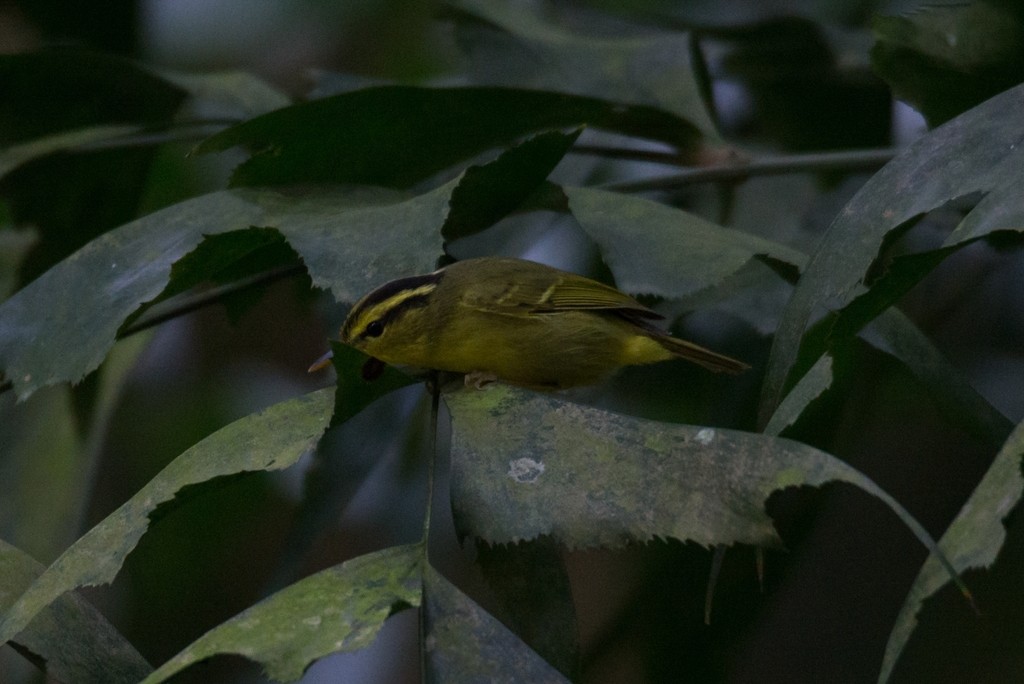Limestone Leaf Warbler
A species of Chiffchaffs And Allies Scientific name : Phylloscopus calciatilis Genus : Chiffchaffs And Allies
Limestone Leaf Warbler, A species of Chiffchaffs And Allies
Botanical name: Phylloscopus calciatilis
Genus: Chiffchaffs And Allies
Content
Description General Info
 Photo By tonipons , used under CC-BY-NC-4.0 /Cropped and compressed from original
Photo By tonipons , used under CC-BY-NC-4.0 /Cropped and compressed from original Description
The limestone leaf warbler (Phylloscopus calciatilis) is smaller than the sulphur-breasted warbler (Phylloscopus ricketti) and has more rounded wings and a proportionately elongated bill. Although a smaller species, the bill is proportionately larger than that of the sulphur-breasted warbler. The plumage is nearly identical, with only a slightly lighter yellow below a grey tinge. Comparisons between these two species suggest it is doubtful that they can be reliably distinguished by plumage alone. The holotype has a wing length of 5.2 cm; in the paratype a tail length of 3.7 cm and a bill length of 1.39 cm. The limestone leaf warbler is greenish-olive in colour with a yellow breast and striped crown. Although it looks similar to other warblers, it can be distinguished by being smaller, having shorter wings, and a larger bill. It is also distinguished by its black lateral crown-stripes, which are paler and more diffuse near the bill. The median crown stripe is greenish-yellow with the Supercilium being yellow with a faint greenish tinge. The eye-stripe on lores and upper ear-coverts are a well defined black colour with a green tinge. The mantle, scapulars, back, rump, lesser and uppertail-coverts are a bright grey-green colour, with the throat, breast and belly a bright yellow. The sides of the breast have a green tinge. The remiges, rectrices, alula, medium, greater and primary coverts are a dark grey colour with a brown tinge, with bright greyish-green outer edges. The juvenile resembles the adults, but has looser, fluffier plumage and, possibly as a result of this, slightly less yellow underparts. It has marginally whiter and more clear-cut pale tips to the greater coverts, and probably slightly more green on the anterior part of the lateral crown-stripes. “In plumage, the Limestone Leaf Warbler appears to be largely indistinguishable from P. ricketti, although as a result of the small number of specimens available for the Limestone Leaf Warbler and their poor quality, detailed comparisons are difficult to make. The only two specimens of the Limestone Leaf Warbler, which have been directly compared with a series of P.ricketti are marginally colder yellow below a more greyish tinge above, and show marginally greyer lateral crown-stripes than P. ricketti. The Limestone Leaf Warbler is easily separable from P. cantator by its yellow belly”. 
Size
11 cm
Nest Placement
Ground
Feeding Habits
Limited information is available on limestone Leaf Warbler's diet; further research is needed to detail its feeding habits and unique dietary adaptations.
Habitat
The limestone Leaf Warbler is typically found in diverse forested habitats associated with limestone karst topography. These include broadleaved evergreen and semi-evergreen forests, mature secondary forests, and tall secondary scrub. Limestone Leaf Warbler inhabits mainly steep slopes and valley floors, thriving in old-growth forests that preferentially grow around rugged limestone mountains. Elevations range from roughly 80 to over 1200 meters, with the species often occupying the taller forest ecosystems in these karst landscapes of broader Southeast Asia.
Dite type
Insectivorous
General Info
Feeding Habits
Bird food type
Distribution Area
The limestone leaf warbler is known to occur in northern Vietnam and Laos, and also occurs in southern China. The species name, calciatilis, means "dwelling on limestone", which refers to its natural habitat, which is broadleaved evergreen and semi-evergreen forest growing around limestone karst mountains around 700-1200m in height. This area is known for its unusual wildlife and includes the Annamite mountain range of Laos. 
Species Status
Scientists presume there are many limestone warblers in this region however its habitat contains threats. Many parts of the species native forests have been cleared for wood collection. WCS is continuing to work with the Lao Government in an effort to reduce the threat to this bird and other wildlife in the area. The conservation of the limestone leaf warbler depends on its habitat rather than being hunted, due to its small size. There are large areas of karst within its known range, and the area it inhabits is generally unsuitable for industrial agriculture or any other type of land conversion. However, some parts of the karst blocks are used for clearing wood for timber and thus is reducing the extent and quality of forest patches. If the species is dependent on taller forests within karst areas, its population may decline. However Laos still has large areas of reasonably tall forest remaining within the limestone karst formations. 
Scientific Classification
Phylum
Chordates Class
Birds Order
Perching birds Family
Phylloscopidae Genus
Chiffchaffs And Allies Species
Limestone Leaf Warbler